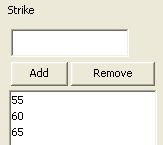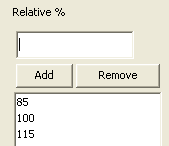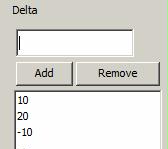EQUITY Volatility Surface
From the Calypso Navigator, navigate to Market Data > Volatilities > Volatility Surface (menu action marketdata.VolatilitySurface3DWindow).
EQUITY volatility surfaces can be created from offset points, or derived from OTC Equity Option or Exchange Traded Option underlying instruments.
| • | Surface from offset points |
| • | Surface from underlying instruments |
| • | Pricer configuration |
 See also Volatility Surface Overview.
See also Volatility Surface Overview.
1. Surface from Offsets
|
EQUITY Volatility Surface from Offsets Quick Reference Configuration Requirements
Surface Generation 1. Click New to start a new surface. 2. The Current checkbox is selected by default, meaning that when you save the surface, the system timestamps the surface with the current date and time. Clear the Current checkbox to enter a back-dated surface. You can modify the date and time fields. 3. Definition Panel — Select the following to define the surface: currency, volatility type “EQUITY”, equity product, strike type, interpolator, the Derived checkbox should not be selected, generator, date-roll convention, holiday calendars, pricing environment. 4. Offsets Panel — Select the tenor and expirations. Enter the strikes / delta values. 5. Points Panel — Click Generate to generate the points. Enter the point values. 6. Click Save, enter a name for the surface, and click OK. Pricer Configuration An EQUITY volatility surface is associated with a pricing environment under the Surfaces panel of the pricer configuration for the volatility type EQUITY and the VOL usage. |
1.1 Definition Panel
Click New to start a new surface.
Select the following to define the surface: currency, volatility type “EQUITY”, equity product, strike type, interpolator, the Derived checkbox should not be selected, generator, date-roll convention, holiday calendars, pricing environment.
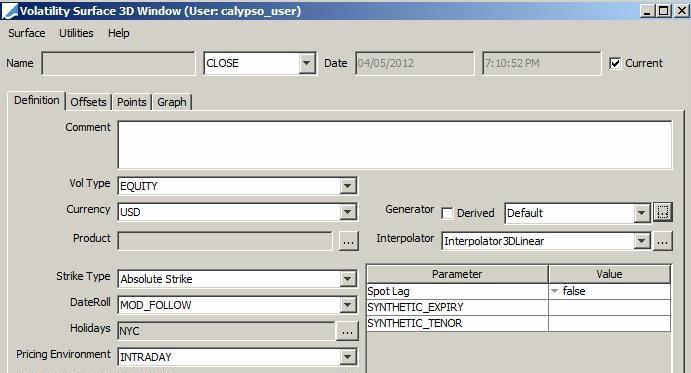
| » | Select the type of strike : Strike, Delta, or Relative % - They are described below. |
| » | Select the generation algorithm: Default, SVISimple, or SplineSimple. |
Default generator - You can set the following generator parameters:
| – | If the spot lag parameter is set to true, the generated exercise dates are rolled using the conventions of the definition screen. |
| – | Note that SYNTHETIC_EXPIRY and SYNTHETIC_TENOR are not currently used. |
SVISimple generator - Support for local volatility model using the SVI methodology, for pricing and risk.
SplineSimple generator - Generation of volatility surface based on delta.
| Surface Type | Description |
|---|---|
|
Strike |
In the Offset panel, enter absolute strikes.
|
|
Relative % |
In the Offset panel, enter a percentage of the current spot. Ⓘ Note: 0% = ATM for offset based relative vol surface & 100%= ATM for derived relative vol surface.
|
| Delta |
In the Offset panel, enter delta values.
|
1.2 Offsets Panel
Select the Offsets panel.

| » | Click ... to select expirations. |
| » | Enter a strike and click Add. Repeat for each strike value. |
1.3 Points Panel
Select the Points panel, and click Generate to generate the points.

| » | Enter market volatilities for each expiration / strike. |
1.4 Save Surface
Click Save in the bottom of the surface window. Enter a name for the surface, and click OK.
2. Surface from Underlying Instruments
|
EQUITY Volatility Surface from Underlying Instruments – Quick Reference Configuration Requirements
Surface Underlying Instruments You can use ETOs, Equity OTC Option and warrants underlying instruments. From the Calypso Navigator, navigate to Configuration > Market Data > Volatility Surface Underlyings, or in the surface application’s Underlyings panel, click New Instrument. Surface Generation 1. Click New to start a new surface. 2. Select the quote instance to use in the surface generation (CLOSE, LAST, or OPEN). 3. The Current checkbox is selected by default, meaning that when you save the surface, the system timestamps the surface with the current date and time. Clear the Current checkbox to enter a back-dated surface. You can modify the date and time fields. 4. Definition Panel — Select the following to define the surface: currency, volatility type “EQUITY”, equity product, strike type, interpolator, select the Derived checkbox, generator, date-roll convention, holiday calendars, pricing environment. 5. Underlyings Panel — Select the underlying instruments. 6. Quotes Panel — Enter quotes manually, use quotes from the quote set, or use real-time quotes. 7. Points Panel — Click Generate to generate the points. 8. Click Save, enter a name for the surface, and click OK. Pricer Configuration An EQUITY volatility surface is associated with a pricing environment under the Surfaces panel of the pricer configuration for the volatility type EQUITY and the VOL usage. |
2.1 Definition Panel
Click New to start a new surface.
Select the following to define the surface: currency, issuer / ticker / or basket, volatility type “EQUITY”, strike type, interpolator, select the Derived checkbox, generator, date-roll convention, holiday calendars, pricing environment.
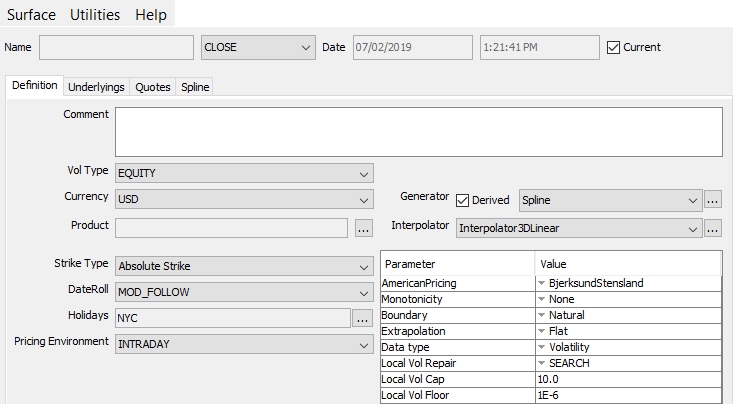
| » | Select the type of strike: |
| Surface Type | Description |
|---|---|
|
Strike |
Absolute strike. The underlying instruments must be specified using an absolute strike.
|
|
Relative % |
% (current strike). The underlying instrument must be specified using a percentage of the current strike. In this example, it is 85% of the current strike.
|
| » | Select the generator: |
| – | The SVI generator allows support for the local volatility model, using the SVI methodology, for pricing and risk. Local volatility surface can be derived from ETO or OTC instruments. |
| – | The Spline generator allows generating a volatility surface from warrants. |
| » | You can set the following generator parameters as desired. |
| Parameter | Description |
|---|---|
|
AmericanPricing |
The default value is BjerksundStensland. This parameter defines the method used to invert American option prices (when the quotes are in price and not in volatility). As of today this is the only supported value. In the future we plan to support the Finite difference method, also used in the Calypso price PricerBlack1FFiniteDifference. The inversion is done with a Brent solver. To invert European option prices, the implied volatility is computed from option prices using P. Jäckel’s method. |
|
Monotonicity |
This parameter offers the possibility to interpolate according to the monotonicity of the data, thereby removing the potential artificial oscillations stemming from cubic splines. None corresponds to the standard cubic spline, no monotonicity constraint is enforced. Hyman83 will apply the monotonicity constraints of Hyman. Hyman89 will apply the less strict monotonicity constraints of Dougherty et al. Note that applying monotonicity constraints means that the interpolant will be only C1 where monotonicity is violated. |
|
Extrapolation |
This parameter controls the extrapolation in the strike space. Flat will flat extrapolate the volatilities. Linear will extrapolate linearly using the slope of the first and last cubic polynomials so that the slice stays C2 with natural boundary conditions. Note that if the data type is variance, the extrapolation will be linear in variance, which is typical of stochastic volatility models behavior (for example Heston). The extrapolation is floored to machine epsilon to avoid negative variance. In general, we recommend Linear as it will lead to a smooth implied volatility and therefore a smooth local volatility with Natural spline boundaries, around the extrapolation. |
|
Data Type |
This parameters controls which data the spline is applied to. Volatility means that the spline is built from strikes and volatilities, strikes being in the unity defined in the volatility surface (absolute, relative, Delta for SplineSimple). Variance means that the spline is built from strikes and the square of volatilities, strikes being in the unity defined in the volatility surface, and input volatilities being internally converted to variances. This is particularly interesting when combined with a linear extrapolation. VarianceLogMoneyness means that the is spline built from log-moneyness log (K/F) and variances σ², strikes are internally converted to log-moneyness. |
|
Local Vol Repair |
This parameter is used when the generator is used with a Local volatility pricer such as PricerLocalVolatility1FFiniteDifference or PricerLocalVolatilityNFMonteCarloExotic. In general we recommend the use of the SVI generator for local volatility, as it is much more robust against arbitrage, but if the quotes are of very good quality then it can make sense to use the Spline generator directly. SEARCH will search for a defined local volatility towards the moneyness and stop at the moneyness, it will then revert to CAP_FLOOR. CAP_FLOOR will use the Cap value if there is a butterfly spread arbitrage (or equivalently, when the local variance denominator becomes negative), it will use the Floor value if there is a calendar spread arbitrage (or equivalently, when the local variance numerator is negative). If Cap and Floor are blank, nothing is done. If only Floor is set and Cap is blank, the local volatility will be floored, even in presence of butterfly spread arbitrage. |
2.2 Underlyings Panel
Select the Underlyings panel.
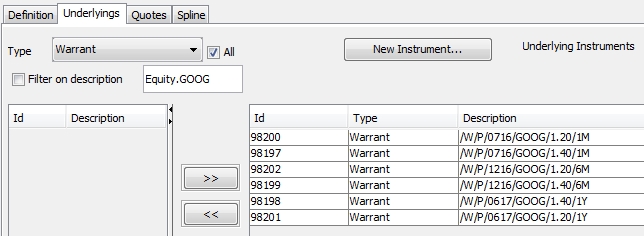
| » | Select the instrument type to display the list of available instruments. The panel is blank if you have not set up any instruments. Click New Instruments to create new instruments. |
| » | Select instruments and click >> to add them to the instrument list in the right panel. |
2.3 Quotes Panel
Select the Quotes panel. Enter quotes for the underlying instruments.

| » | You can click Save Quotes to save the quotes. |
| » | You can choose to display the quotes in a as shown above, or as a list. |
2.4 Spline Panel
Select the Spline panel, and click Generate to generate the points.
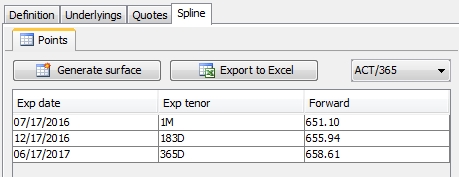
2.5 Save Surface
Click Save in the bottom of the surface window. Enter a name for the surface, and click OK.
3. Pricer Configuration
From the Calypso Navigator, navigate to Market Data > Pricing Environment > Pricer Configuration.
Click Load, and select a pricer configuration.
Select the Surfaces panel.

| » | Select the volatility type EQUITY, select an equity product or ANY. |
| » | Click ... to select the volatility surface. |
| » | Select the VOL usage. |
| » | Click Add to add the surface to the list. |
| » | Click Save to save the pricer configuration. |
